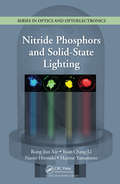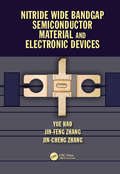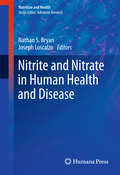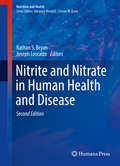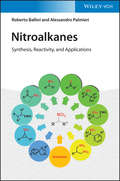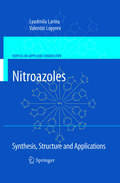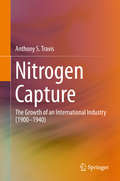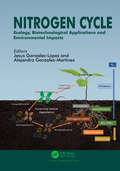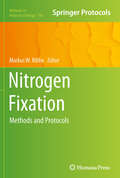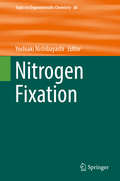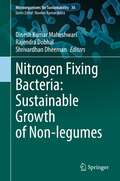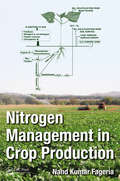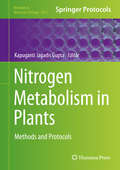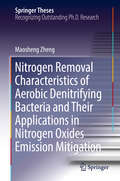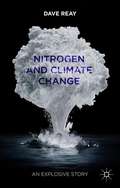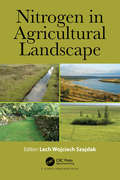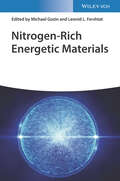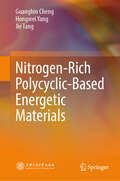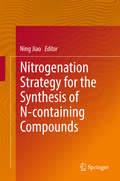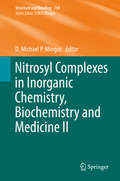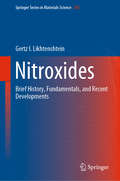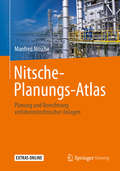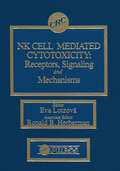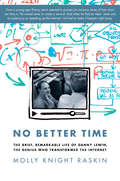- Table View
- List View
Nitride Phosphors and Solid-State Lighting (Series in Optics and Optoelectronics)
by Hajime Yamamoto Rong-Jun Xie Yuan Qiang Li Naoto HirosakiNitride Phosphors and Solid-State Lighting provides an in-depth introduction to the crystal chemistry, synthesis, luminescence, and applications of phosphor materials for solid-state lighting, mainly focusing on new nitride phosphors. Drawing on their extensive experimental work, the authors offer a multidisciplinary study of phosphor materials tha
Nitride Wide Bandgap Semiconductor Material and Electronic Devices
by Yue Hao Jin Feng Zhang Jin Cheng ZhangThis book systematically introduces physical characteristics and implementations of III-nitride wide bandgap semiconductor materials and electronic devices, with an emphasis on high-electron-mobility transistors (HEMTs). The properties of nitride semiconductors make the material very suitable for electronic devices used in microwave power amplification, high-voltage switches, and high-speed digital integrated circuits.
Nitrite and Nitrate in Human Health and Disease
by Joseph Loscalzo Nathan BryanNitrite and Nitrate in Human Health and Disease delivers a comprehensive review of nitrite and nitrate biology, from basic biochemistry to the complex physiology and metabolism of these two naturally occurring molecules in the human body. Well-organized and well referenced chapters cover the rich history of nitrite and nitrate, sources of exposure, and the physiological effects when consumed through foods containing nitrite and nitrate. The chapters are written by leading experts, all of whom share their research and perspectives in order to help define the context for benefits vs. any potential risks associated with nitrite and nitrate use, either through dietary ingestion or therapeutic dosing. This diverse collection of authors includes vascular biologists, physiologists, physicians, epidemiologists, cancer biologists, registered dieticians, chemists, and public health experts from five countries in both academia and government. Nitrite and Nitrate in Human Health and Disease provides a balanced view of nitric oxide biochemistry, and nitrite and nitrate biochemistry in physiology and in the food sciences.
Nitrite and Nitrate in Human Health and Disease
by Joseph Loscalzo Nathan S. BryanThis fully revised and updated new edition provides a comprehensive look at nitrite and nitrate and their effect on human health and disease. The first section describes the biochemical analysis of nitrite and nitrate and its role in human physiology. The book then shifts to sources of human exposure of nitrite and nitrate, including environmental and dietary. Finally, the last section discusses nitric oxide-based therapeutics and how nitrite and nitrate biochemistry can be safely harnessed to improve human health. Each chapter provides a balanced, evidence-based view and heavily cites the most recent published literature. They follow a strict chapter format which includes keywords, key points, a conclusion highlighting major findings, and extensive references. The second edition contains new chapters on nitrite and nitrate in age medicine, nitrite and nitrate as a treatment for hypertension, and nitrite and nitrate in exercise performance. Additionally, the editors have expanded the biochemistry section to include chapters on nitrate reducing oral bacteria, nitrite mediated S-Nitrosation, epigenetics and the regulation of nitric oxide, and nitrite control of mitochondrial function. Nitrate and Nitrite in Human Health and Disease, 2e, will be of interest to health professionals, nutritionists, dieticians, biomedical scientists, and food scientists.
Nitroalkanes: Synthesis, Reactivity, and Applications
by Roberto Ballini Alessandro PalmieriDiscover a comprehensive exploration of recent progress in the preparation of nitroalkanes from two leading voices in the fieldNitroalkanes: Synthesis, Reactivity, and Applications delivers a thorough summary of the importance of nitroalkanes in organic synthesis. The book covers their preparation, transformation into other functional groups, like carbonyls and amines, and their use in the formation of single carbon-carbon or double carbon-carbon bonds. The distinguished authors have included chapters on acyclic and cyclic alpha-nitro ketones as well as the synthesis of cyclopropanes and spiro ketals.The book provides treatments of the application of nitroalkanes for the synthesis of important heterocycles, poly-functionalized structures, natural products, and compounds of biological and pharmaceutical interest. A one-stop resource in a topic that hasn???t been fully addressed by any other book in decades, this book covers the most important synthetic routes toward nitroalkanes.Readers will also benefit from the inclusion of:A thorough introduction to the synthesis of nitroalkanes, as well as the transformation of the nitro group into other functionalitiesAn exploration of the formation of C-C single bonds, C=C double bonds, and the breaking of C3C bonds from cyclic alpha-nitro ketonesDiscussions of acyclic alpha-nitro ketones, nitroalkanes as precursors of cyclopropanes, and the synthesis of spiro ketalsAn examination of the preparation and synthetic applications of 1,3-DinitroalkanesPerfect for organic chemists, natural products chemists, and catalytic chemists, Nitroalkanes: Synthesis, Reactivity, and Applications will also earn a place in the libraries of medicinal chemists seeking a one-stop resource for the most recent developments in the preparation of nitroalkanes, their functionalization, and their applications.
Nitroazoles: Synthesis, Structure and Applications
by Lyudmila Larina Valentin LopyrevThe monograph gives an exhaustive and systematic description of the methods of synthesis, application, structure and properties of nitroazoles perspective medicines, universal bases in peptide nucleic acids, agrochemicals, and components of high-energy materials. All five-membered nitroderivatives of azoles - pyrazoles, imidazoles, triazoles, tetrazoles, oxazoles, isoxazoles, oxadiazoles, thiazoles, isothiazoles, thiadiazoles, and their benzanalogs - indazoles, benzimidazoles, benzoxazoles, benzisoxazoles, benzoxadiazoles, benzothiazoles, benzoisothiazoles, benzothiadiazoles, benzotriazoles are discussed in the book. Special attention is paid to the nitroimidazole derivatives many of which are well-known drugs and hypoxic cell radiosensitizers (azomycine, metronidazole, misonidazole, tinidazole, dimetridazole, ipronidazole, carnidazole and etc). The critical evaluation of a large body of the information on nitroazoles investigations by physicochemical methods (NMR, NQR, ESR, UV, IR- specrtoscopy, X-ray, mass-spectrometry, polarography, dipole moments and others methods) is presented here.
Nitrogen Capture: The Growth Of An International Industry (1900-1940)
by Anthony S. TravisThis monograph provides an account of how the synthetic nitrogen industry became the forerunner of the 20th-century chemical industry in Europe, the United States and Asia. Based on an earlier SpringerBrief by the same author, which focused on the period of World War I, it expands considerably on the international aspects of the development of the synthetic nitrogen industry in the decade and a half following the war, including the new technologies that rivalled the Haber-Bosch ammonia process. Travis describes the tremendous global impact of fixed nitrogen (as calcium cyanamide and ammonia), including the perceived strategic need for nitrogen (mainly for munitions), and, increasingly, its role in increasing crop yields, including in Italy under Mussolini, and in the Soviet Union under Stalin. The author also reviews the situation in Imperial Japan, including the earliest adoption of the Italian Casale ammonia process, from 1923, and the role of fixed nitrogen in the industrialization of colonial Korea from the late 1920s. Chemists, historians of science and technology, and those interested in world fertilizer production and the development of chemical industry during the first four decades of the twentieth century will find this book of considerable value.
Nitrogen Cycle: Ecology, Biotechnological Applications and Environmental Impacts
by Jesus Gonzalez-LopezAnthropogenic activity has clearly altered the N cycle contributing (among other factors) to climate change. This book aims to provide new biotechnological approach representing innovative strategies to solve specific problems related to the imbalance originating in the N cycle. Aspects such as new conceptions in agriculture, wastewater treatment, and greenhouse gas emissions are discussed in this book with a multidisciplinary vision. A team of international authors with wide experience have contributed up-to-date reviews, highlighting scientific principles and their environmental importance and integrating different biotechnological processes in environmental technology.
Nitrogen Deposition, Critical Loads and Biodiversity
by Mark A. Sutton Kate E. Mason Lucy J. Sheppard Harald Sverdrup Richard Haeuber W. Kevin HicksThis volume brings together extended reviews and papers of new scientific research on atmospheric nitrogen deposition impacts globally. While there is a wealth of evidence on the magnitude, components and effects of nitrogen disposition on floral biodiversity in Europe and North America, there is an obvious lack of information on impacts on above- and below-ground fauna, and all impacts in other parts of the world, with no clear overview of how the different strands of evidence fit together. This overall synthesis is targeted at the international conventions, but is equally readable for scientists, environmental managers, conservation agencies and policy makers. 'This timely book highlights the global nitrogen deposition problem. Major regions of the world are exceeding sustainability thresholds for adverse effects on ecosystem function and biodiversity. This highlights the importance of ongoing work, including under the Convention on Biological Diversity, in developing indicators and monitoring nitrogen deposition effects to enable appropriate measures. This book presents a milestone towards this global goal as the international community works toward meeting the Aichi Biodiversity Targets, especially Target 8: "By 2020, pollution, including from excess nutrients, has been brought to levels that are not detrimental to ecosystem function and biodiversity". Braulio Ferreira de Souza Dias, Executive Secretary, Convention on Biological Diversity "This key volume highlights the global challenge to reduce atmospheric nitrogen pollution resulting from energy production, transport and agricultural activities. It takes forward the agenda recently launched in the UNEP commissioned report 'Our Nutrient World". Dr. Anjan Datta, UNEP.
Nitrogen Fixation
by Markus W. RibbeFew problems in protein biochemistry have proven to be as challenging and recalcitrant as the molecular description of nitrogenase, the catalyst of one of the most remarkable chemical transformations in biological systems: the nucleotide-dependent reduction of atmospheric dinitrogen to bioavailable ammonia. In Nitrogen Fixation: Methods and Protocols, recognized experts in the field provide an up-to-date, in-depth overview of the methods that have been applied to studying the nitrogenase at a molecular level, ranging from genetic, biochemical, spectroscopic, and chemical methods to theoretical calculations. In addition, techniques used to study an enzyme system that is homologous to nitrogenase are described in this book. Written in the highly successful Methods in Molecular BiologyTM series format, methods chapters include introductions to their respective chapters, lists of the necessary materials and reagents, step-by-step, readily reproducible laboratory protocols, and tips on troubleshooting and avoiding known pitfalls. Practical and cutting-edge, Nitrogen Fixation: Methods and Protocols will be useful for anyone interested in nitrogenase research and willing to venture further toward addressing the remaining mechanistic and biosynthetic questions of this fascinating enzyme system.
Nitrogen Fixation
by Yoshiaki NishibayashiThis volume presents a review of recent developments in nitrogen fixation using transition metal-dinitrogen complexes in the last decade. The authors are international experts in the corresponding field and each chapter discusses their latest achievements in the preparation of various transition metal-dinitrogen complexes and their reactivity. This volume will be helpful to researchers, teachers, and students who are interested in innovative and sustainable chemistry.
Nitrogen Fixing Bacteria: Sustainable Growth of Non-legumes (Microorganisms for Sustainability #36)
by Dinesh Kumar Maheshwari Shrivardhan Dheeman Rajendra DobhalThis book covers aspects of biological nitrogen fixation along with the unique signaling and interaction between the diazotrophic bacteria and plants, especially the non-legumes. Nitrogen is the most important growth-limiting nutrient in the ecosystems and biological nitrogen fixation involving microbial symbionts, mainly rhizobia and legumes holds enormous interest across the globe. However, free-living rhizobacteria of non-legumes especially cereals, also establish themselves within the root system, fixing nitrogen and contributing to plant productivity, soil fertility, and agricultural sustainability. These non-symbiotic nitrogen fixers additionally exhibit various plant growth-promoting traits elevating productivity, fortifying nutrient content, and managing water stress in plants. The recent perspectives highlighting the mechanisms and background of non-symbiotic nitrogen fixation provide answers to unravel the potential of nitrogenase and various spectra of habitats of rhizobia and other diazotrophic bacteria. Further, the application of genetic engineering and the development of nitrogen-fixing cereals can provide a possible solution to the problem of food shortage. The book includes various scientific inputs providing comprehensive knowledge about the emergence of agricultural sustainability through nitrogen-fixing bacteria. The book illustrates the systematic mechanisms involved in biological nitrogen fixation through various illustrations, schematic drawings, and flow charts aiding in better understanding. The chapters elaborate on the physiology and metabolism of plant-bacteria interaction in different crops under diverse environmental conditions. Thus, the volume will provide a holistic scenario helping in advancing the novel plant-microbe interactions, cell-signaling, and plant-molecular interactions. The book will assist the agronomists, microbiologists, ecologists, plant pathologists, molecular biologists, environmentalists, policymakers, conservationists, and NGOs to develop biofertilizers and bioinoculants using various genera of microbes and contribute to the targets of sustainable goals in an eco-friendly manner.
Nitrogen Management in Crop Production
by Nand Kumar FageriaOne of the main approaches for safeguarding food security, sustainable development has increased demand for knowledge on fertilizer management in crop production. Among essential plant nutrients, nitrogen is one of the most important yield-limiting nutrients, mainly responsible for determining yield and yield components in cereals and legumes. It i
Nitrogen Metabolism in Plants: Methods and Protocols (Methods in Molecular Biology #2057)
by Kapuganti Jagadis GuptaThis volume explores several different aspects of nitrogen metabolism, ranging from nitrogen uptake to assimilation. The chapters in this book cover topics such as measurement of activities of enzymes involved in nitrogen metabolism (i.e., nitrate reductase); measurement of nitric oxide, nitrite and ways to detect the N content in plants and microbes; characterization of root nodule bacteria (RNB); and techniques to perform proteomics of Extracellular Matrix (ECM). Written in the highly successful Methods in Molecular Biology series format, chapters include introductions to their respective topics, lists of the necessary materials and reagents, step-by-step, readily reproducible laboratory protocols, and tips on troubleshooting and avoiding known pitfalls.Thorough and cutting-edge, Nitrogen Metabolism in Plants: Methods and Protocols is a valuable tool for novice and expert researchers who are interested in learning more about this evolving field.
Nitrogen Removal Characteristics of Aerobic Denitrifying Bacteria and Their Applications in Nitrogen Oxides Emission Mitigation (Springer Theses)
by Maosheng ZhengThis book systematically investigates the nitrogen removal characteristics of two screened aerobic denitrifying bacteria and their applications in nitrogen oxides emissions reduction. It reveals that Pseudomonas stutzeri PCN-1 possesses excellent capacity for aerobic nitrogen removal, regardless of whether nitrate, nitrite or N2O were taken as denitrification substrates. It also demonstrates that the rapid N2O reduction is due to the coordinate expression of denitrification genes. Further, the book discusses the bioaugmentation experiments conducted in denitrifying SBR and a pilot-scale Carrousel oxidation ditch, which confirmed that the strain could significantly enhance denitrification performance, reduce N2O emission and improve system stability. The second strain, P.aeruginosa PCN-2 accumulated negligible NO during aerobic nitrate and nitrite removal and efficiently removed NO from flue gas. This study is of great significance for potential applications of aerobic denitrification in mitigating nitrogen oxides emissions from biological nitrogen removal systems.
Nitrogen and Climate Change
by Dave ReayIt is the perfect storm. Limited food, water and energy unequally spread between an expanding population, and a warming climate as the bitter icing on the cake. In all these global challenges nitrogen has a leading role to play. In Nitrogen and Climate Change, Dave Reay looks at just how hard-wired into all of human civilisation nitrogen is, and whether the future will see it as our quiet savior or the toxic villain of the piece. Its story is of the peculiar and the mundane, of water turning red and people turning blue. It is one of climate friend and pollution foe, of meaty feasts and looming famine. If your main thought of nitrogen is as a boring corner of the periodic table, then it is time to look again.
Nitrogen in Agricultural Landscape
by Lech Wojciech SzajdakAgriculture transforms the environment. The simplification of agroecosystems structure increases the hazards of leaching, wind and water erosion, and volatilization of chemicals from soil. Soil nitrogen is of interest as a major crop nutrient, but also as a potential environmental pollutant. Knowledge about the behavior of soil nitrogen is desirable in order to optimize plant growth and crop yield and to minimize environmental side effects. This book also gives information about the function of biogeochemical barriers in the form of shelterbelts, which efficiently decrease the concentrations of various forms of nitrogen in ground water.
Nitrogen-Rich Energetic Materials
by Michael Gozin Leonid L. FershtatNitrogen-Rich Energetic Materials Provides in-depth and comprehensive knowledge on both the chemistry and practical applications of nitrogen-rich energetic materials Energetic materials, a class of material with high amounts of stored chemical energy, include explosives, pyrotechnics, and propellants. Initially used for military applications, nitrogen-rich energetic materials have become important in the civil engineering and aerospace sectors, they are increasingly used in commercial mining and construction as well as in rocket propulsion. Making these nitrogen-rich energetic materials safer, more powerful, and more cost-effective requires a thorough understanding of their chemistry, physics, synthesis, properties, and applications. Nitrogen-Rich Energetic Materials presents a detailed summary of the development of nitrogen-rich energetic materials over the past decade and provides up-to-date knowledge on their applications in various areas of advanced engineering. Edited by a panel of international experts in the field, this book examines the chemistry of pentazoles, fused ring and laser ignitable nitrogen-rich compounds, polynitrogen and tetrazole-based energetic compounds, and more. The text also introduces applications of nitrogen-rich energetic materials in energetic polymers and metal-organic frameworks, as pyrotechnics materials for light and smoke, and in oxadiazoles from precursor molecules. This authoritative volume: Presents in-depth chapters written by leading experts in each sub-field covered Offers a systematic introduction to new and emerging applications of nitrogen-rich energetic materials such as in computational chemistry Discusses recent advances in nitrate ester chemistry with focus on propellant applications Discusses green and eco-friendly approaches to nitrogen-rich compounds Nitrogen-Rich Energetic Materials is an important resource for researchers, academics, and industry professionals across fields, including explosives specialists, pyrotechnicians, materials scientists, polymer chemists, laser specialists, physical chemists, environmental chemists, chemical engineers, and safety officers.
Nitrogen-Rich Polycyclic-Based Energetic Materials
by Jie Tang Guangbin Cheng Hongwei YangThis book describes the design, synthesis, performance and practical application of energetic materials. The book consists of thirteen chapters demonstrating the design routes of nitrogen-rich polycyclic-based energetic materials that are bicyclic, tricyclic and tetracyclic-based. It presents the synthesis of the energetic backbone, the construction of linkage and the introduction of energetic units, which could have a positive impact on the chemistry of not only on high-energy-density materials but also in other fields. The book also provides detailed analysis of the experimental methods discussed. Work in this area will benefit from the combine expertise from organic, inorganic and physical chemistry as well as other connected disciplines. As such this book has wide appeal and will help in increasing fundamental knowledge of nitrogen-rich heterocycles to eventually allow for this knowledge to be transferred into industrial applications.
Nitrogenation Strategy for the Synthesis of N-containing Compounds
by Ning JiaoThis book focuses on direct nitrogenation strategies to incorporate one or more N-atoms into simple substrates especially hydrocarbons via C-H and/or C-C bond cleavage, which is a green and sustainable way to synthesize nitrogen-containing compounds. The book consists of seven chapters demonstrating interesting advances in the preparation of amines, amides, nitriles, carbamides, azides, and N-heterocyclic compounds and illustrating the mechanisms of these novel transformations. It offers an accessible introduction to nitrogenation reactions for chemists involved in N-compound synthesis and those interested in discovering new reagents and reactions. Ning Jiao is a Professor of Chemistry at Peking University, China.
Nitrosyl Complexes in Inorganic Chemistry, Biochemistry and Medicine I
by D. Michael P. MingosThe series Structure and Bonding publishes critical reviews on topics of research concerned with chemical structure and bonding. The scope of the series spans the entire Periodic Table and addresses structure and bonding issues associated with all of the elements. It also focuses attention on new and developing areas of modern structural and theoretical chemistry such as nanostructures, molecular electronics, designed molecular solids, surfaces, metal clusters and supramolecular structures. Physical and spectroscopic techniques used to determine, examine and model structures fall within the purview of Structure and Bonding to the extent that the focus is on the scientific results obtained and not on specialist information concerning the techniques themselves. Issues associated with the development of bonding models and generalizations that illuminate the reactivity pathways and rates of chemical processes are also relevant. The individual volumes in the series are thematic. The goal of each volume is to give the reader, whether at a university or in industry, a comprehensive overview of an area where new insights are emerging that are of interest to a larger scientific audience. Thus each review within the volume critically surveys one aspect of that topic and places it within the context of the volume as a whole. The most significant developments of the last 5 to 10 years should be presented using selected examples to illustrate the principles discussed. A description of the physical basis of the experimental techniques that have been used to provide the primary data may also be appropriate, if it has not been covered in detail elsewhere. The coverage need not be exhaustive in data, but should rather be conceptual, concentrating on the new principles being developed that will allow the reader, who is not a specialist in the area covered, to understand the data presented. Discussion of possible future research directions in the area is welcomed. Review articles for the individual volumes are invited by the volume editors. Readership: research scientists at universities or in industry, graduate students Special offer For all customers who have a standing order to the print version of Structure and Bonding, we offer free access to the electronic volumes of the Series published in the current year via SpringerLink.
Nitroxides: Brief History, Fundamentals, and Recent Developments (Springer Series in Materials Science #292)
by Gertz I. LikhtenshteinWritten by a pioneer in the development of spin labeling in biophysics, this expert book covers the fundamentals of nitroxide spin labeling through cutting-edge applications in chemistry, physics, materials science, molecular biology, and biomedicine. Nitroxides have earned their place as one of the most popular organic paramagnets due to their suitability as inhibitors of oxidative processes, as a means to polarize magnetic nuclei, and, in molecular biology, as probes and labels to understand molecular structures and dynamics AS DRAGS FOR CANCER AND OTHER DISEASES. Beginning with an overview of the basic methodology and nitroxides’ 145-year history, this book equips students with necessary background and techniques to undertake original research and industry work in this growing field.
Nitsche-Planungs-Atlas: Planung und Berechnung verfahrenstechnischer Anlagen
by Manfred NitscheDieses Fachbuch erläutert die Vorgehensweise beim Planen und Bauen einer verfahrenstechnischen Anlage. Eine verfahrenstechnische Planung besteht aus der Berechnung und Auslegung von Apparaten, Maschinen und Hilfsanlagen sowie der Organisation des Planungsablaufs. Aus diesem Grund werden in diesem Werk auch die verfahrenstechnischen Berechnungen sowie der organisatorische Ablauf in der Praxis behandelt - unter Berücksichtigung der jeweiligen Vorschriften in dem Land und ergänzt durch zahlreiche Beispiele. Ein Wärmetauscher, eine Kolonne oder ein Reaktor muss berechnet werden. Für die ausgelegten Apparate und Maschinen werden die Anfragen spezifiziert. Auch Rohrleitungen, Pumpen und Regelventile müssen ausgelegt werden. Hier ist Kreativität gefragt, Probleme müssen gelöst werden. Die Betriebsmittelversorgung muss sichergestellt sein. Auch die wirtschaftlichen Anforderungen müssen mit den physikalischen Gesetzen und den Vorschriften in den verschiedenen Ländern in Einklang gebracht werden.
Nk Cell Mediated Cytotoxicity: Receptors, Signaling, and Mechanisms
by Eva LotzovaThis volume provides a state-of-the-art survey of developments in the field of NK cell-cancer cell interactions, activation, and oncolytic signaling. Specific topics discussed include NK cell receptors and adhesion molecules, signal transduction and activation, and mechanisms of cytotoxicity. The book will be an excellent learning tool and reference resource for scientists, clinicians, and students.
No Better Time: The Brief, Remarkable Life of Danny Lewin, the Genius Who Transformed the Internet
by Molly Knight RaskinNo Better Time tells of a young, driven mathematical genius who wrote a set of algorithms that would create a faster, better Internet. It's the story of a beautiful friendship between a loud, irreverent student and his soft-spoken MIT professor, of a husband and father who spent years struggling to make ends meet only to become a billionaire almost overnight with the success of Akamai Technologies, the Internet content delivery network he cofounded with his mentor.Danny Lewin's brilliant but brief life is largely unknown because, until now, those closest to him have guarded their memories and quietly mourned their loss. For Lewin was almost certainly the first victim of 9/11, stabbed to death at age 31 while trying to overpower the terrorists who would eventually fly American Flight 11 into the World Trade Center. But ironically it was 9/11 that proved the ultimate test for Lewin's vision--while phone communication failed and web traffic surged as never before, the critical news and government sites that relied on Akamai--and the technology pioneered by Danny Lewin--remained up and running.
